Effective Business Communication Audit Report for Data Solutions Ltd
VerifiedAdded on 2021/04/17
|6
|1154
|88
Report
AI Summary
This report presents the findings of a communication audit conducted at Data Solutions Ltd. The audit, which examined both internal and external communications, employed interviews and a SWOT analysis to evaluate the organization's communication processes and channels. The specific objective was to identify strengths and weaknesses in internal communication, with the aim of improving future communications by addressing existing gaps. Key problems identified include the inappropriate use of communication methods, a limited internal communication network, and ineffective inter-organizational meetings. The report highlights the negative impacts of these issues on employee engagement, information flow, and overall organizational output. Proposed solutions involve training on effective communication, modifications to the internal communication system, and the implementation of a social platform for meetings. The report emphasizes the importance of staff compliance with the recommendations to foster healthy interrelations, a positive work environment, and the achievement of organizational goals.
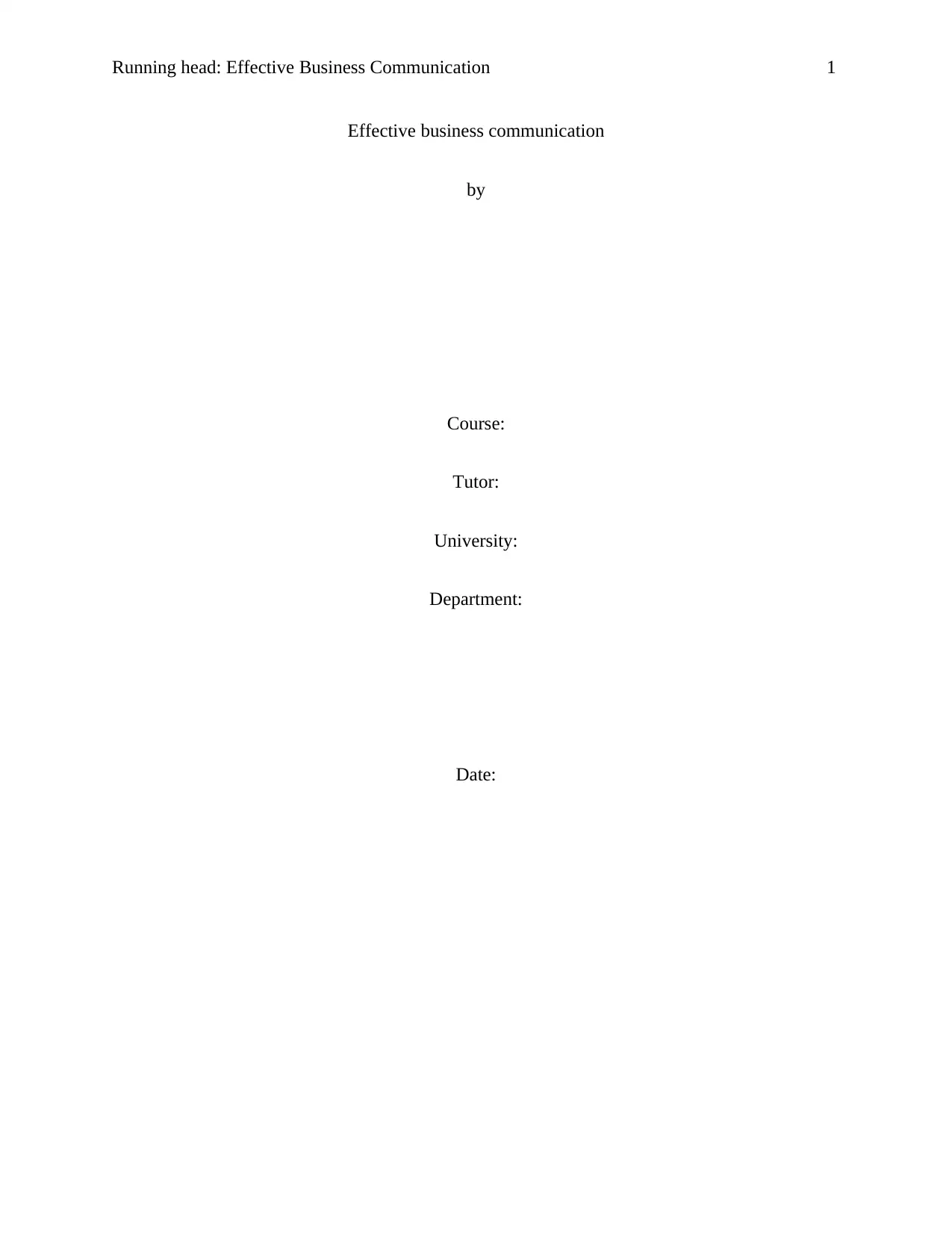
Running head: Effective Business Communication 1
Effective business communication
by
Course:
Tutor:
University:
Department:
Date:
Effective business communication
by
Course:
Tutor:
University:
Department:
Date:
Paraphrase This Document
Need a fresh take? Get an instant paraphrase of this document with our AI Paraphraser
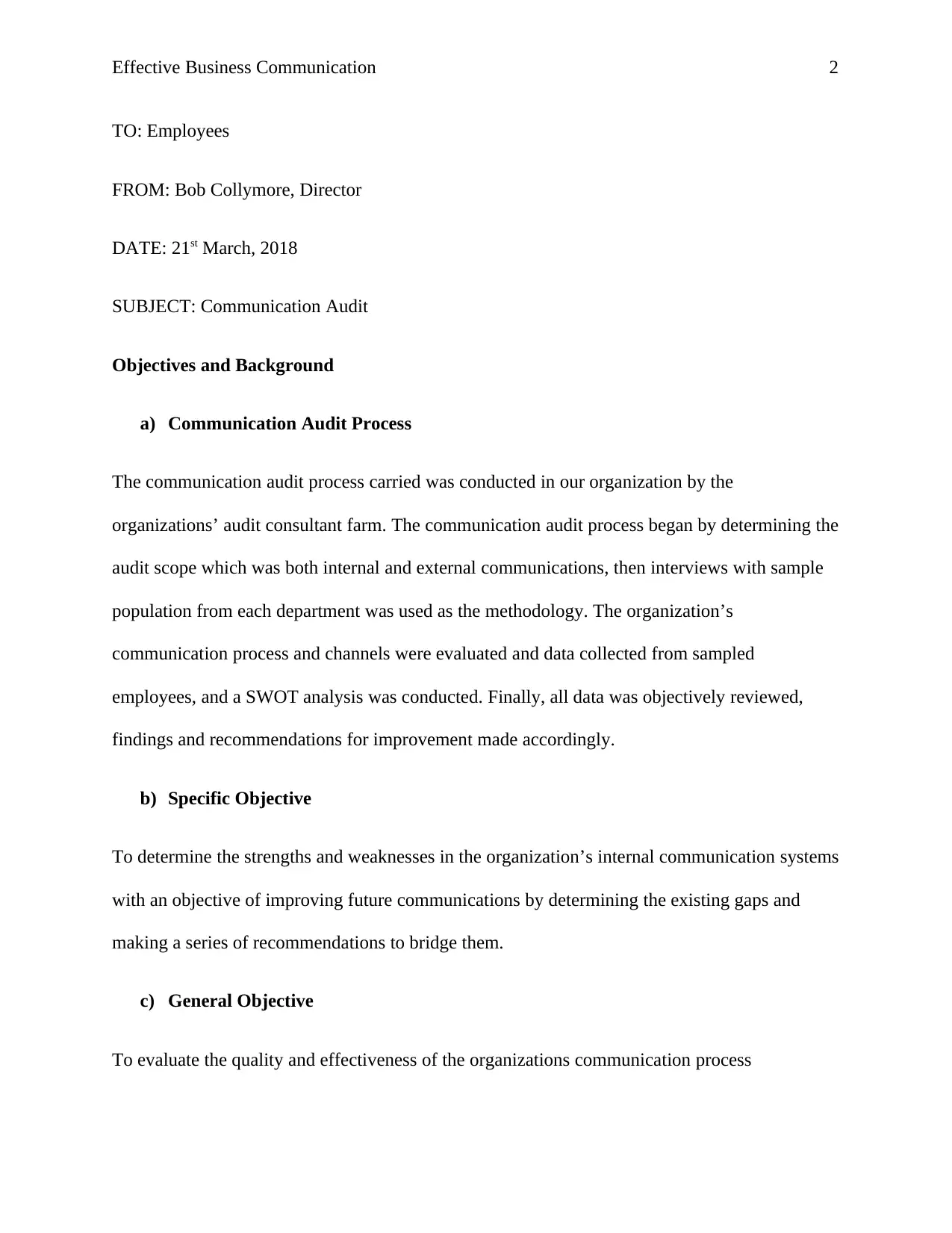
Effective Business Communication 2
TO: Employees
FROM: Bob Collymore, Director
DATE: 21st March, 2018
SUBJECT: Communication Audit
Objectives and Background
a) Communication Audit Process
The communication audit process carried was conducted in our organization by the
organizations’ audit consultant farm. The communication audit process began by determining the
audit scope which was both internal and external communications, then interviews with sample
population from each department was used as the methodology. The organization’s
communication process and channels were evaluated and data collected from sampled
employees, and a SWOT analysis was conducted. Finally, all data was objectively reviewed,
findings and recommendations for improvement made accordingly.
b) Specific Objective
To determine the strengths and weaknesses in the organization’s internal communication systems
with an objective of improving future communications by determining the existing gaps and
making a series of recommendations to bridge them.
c) General Objective
To evaluate the quality and effectiveness of the organizations communication process
TO: Employees
FROM: Bob Collymore, Director
DATE: 21st March, 2018
SUBJECT: Communication Audit
Objectives and Background
a) Communication Audit Process
The communication audit process carried was conducted in our organization by the
organizations’ audit consultant farm. The communication audit process began by determining the
audit scope which was both internal and external communications, then interviews with sample
population from each department was used as the methodology. The organization’s
communication process and channels were evaluated and data collected from sampled
employees, and a SWOT analysis was conducted. Finally, all data was objectively reviewed,
findings and recommendations for improvement made accordingly.
b) Specific Objective
To determine the strengths and weaknesses in the organization’s internal communication systems
with an objective of improving future communications by determining the existing gaps and
making a series of recommendations to bridge them.
c) General Objective
To evaluate the quality and effectiveness of the organizations communication process
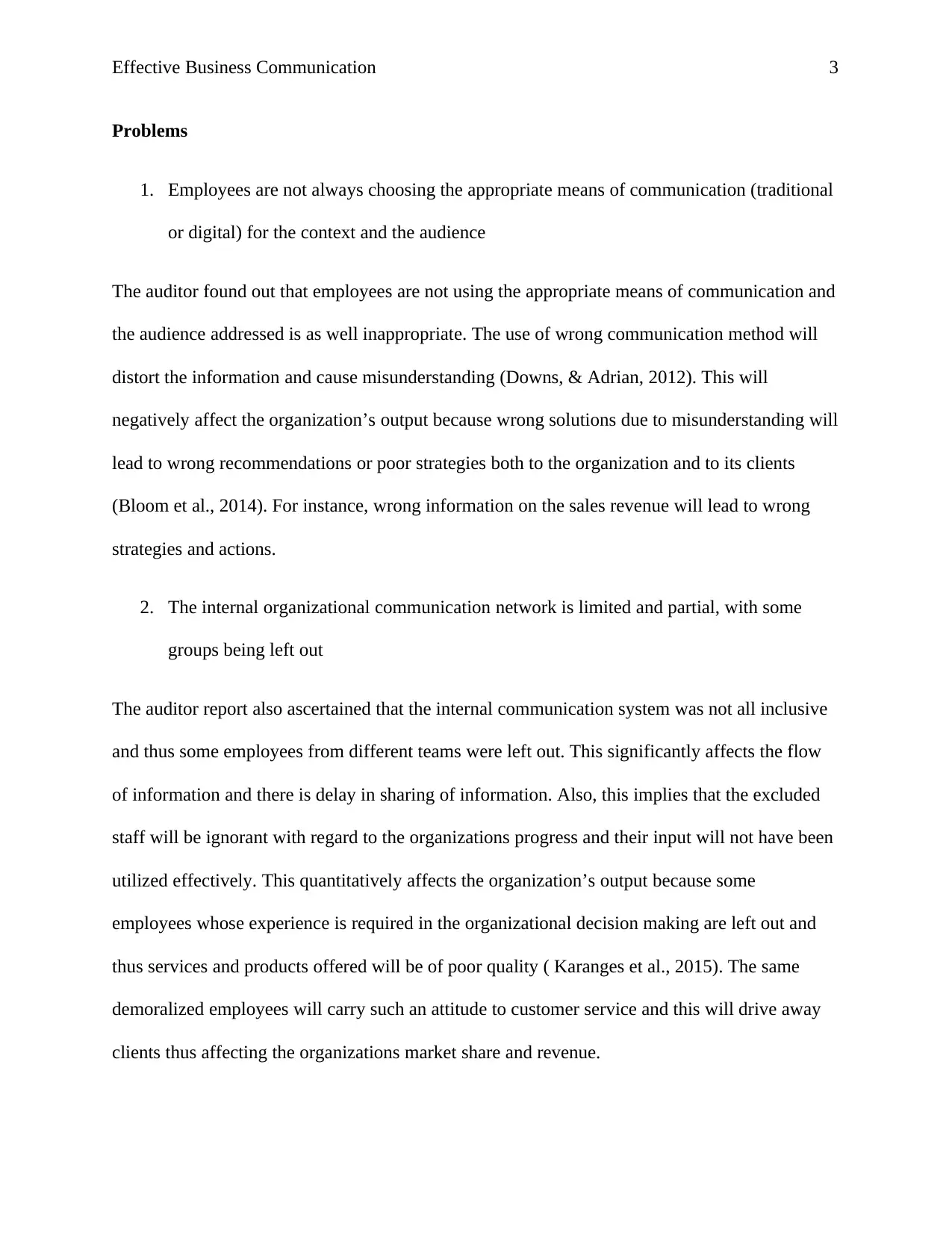
Effective Business Communication 3
Problems
1. Employees are not always choosing the appropriate means of communication (traditional
or digital) for the context and the audience
The auditor found out that employees are not using the appropriate means of communication and
the audience addressed is as well inappropriate. The use of wrong communication method will
distort the information and cause misunderstanding (Downs, & Adrian, 2012). This will
negatively affect the organization’s output because wrong solutions due to misunderstanding will
lead to wrong recommendations or poor strategies both to the organization and to its clients
(Bloom et al., 2014). For instance, wrong information on the sales revenue will lead to wrong
strategies and actions.
2. The internal organizational communication network is limited and partial, with some
groups being left out
The auditor report also ascertained that the internal communication system was not all inclusive
and thus some employees from different teams were left out. This significantly affects the flow
of information and there is delay in sharing of information. Also, this implies that the excluded
staff will be ignorant with regard to the organizations progress and their input will not have been
utilized effectively. This quantitatively affects the organization’s output because some
employees whose experience is required in the organizational decision making are left out and
thus services and products offered will be of poor quality ( Karanges et al., 2015). The same
demoralized employees will carry such an attitude to customer service and this will drive away
clients thus affecting the organizations market share and revenue.
Problems
1. Employees are not always choosing the appropriate means of communication (traditional
or digital) for the context and the audience
The auditor found out that employees are not using the appropriate means of communication and
the audience addressed is as well inappropriate. The use of wrong communication method will
distort the information and cause misunderstanding (Downs, & Adrian, 2012). This will
negatively affect the organization’s output because wrong solutions due to misunderstanding will
lead to wrong recommendations or poor strategies both to the organization and to its clients
(Bloom et al., 2014). For instance, wrong information on the sales revenue will lead to wrong
strategies and actions.
2. The internal organizational communication network is limited and partial, with some
groups being left out
The auditor report also ascertained that the internal communication system was not all inclusive
and thus some employees from different teams were left out. This significantly affects the flow
of information and there is delay in sharing of information. Also, this implies that the excluded
staff will be ignorant with regard to the organizations progress and their input will not have been
utilized effectively. This quantitatively affects the organization’s output because some
employees whose experience is required in the organizational decision making are left out and
thus services and products offered will be of poor quality ( Karanges et al., 2015). The same
demoralized employees will carry such an attitude to customer service and this will drive away
clients thus affecting the organizations market share and revenue.
⊘ This is a preview!⊘
Do you want full access?
Subscribe today to unlock all pages.

Trusted by 1+ million students worldwide
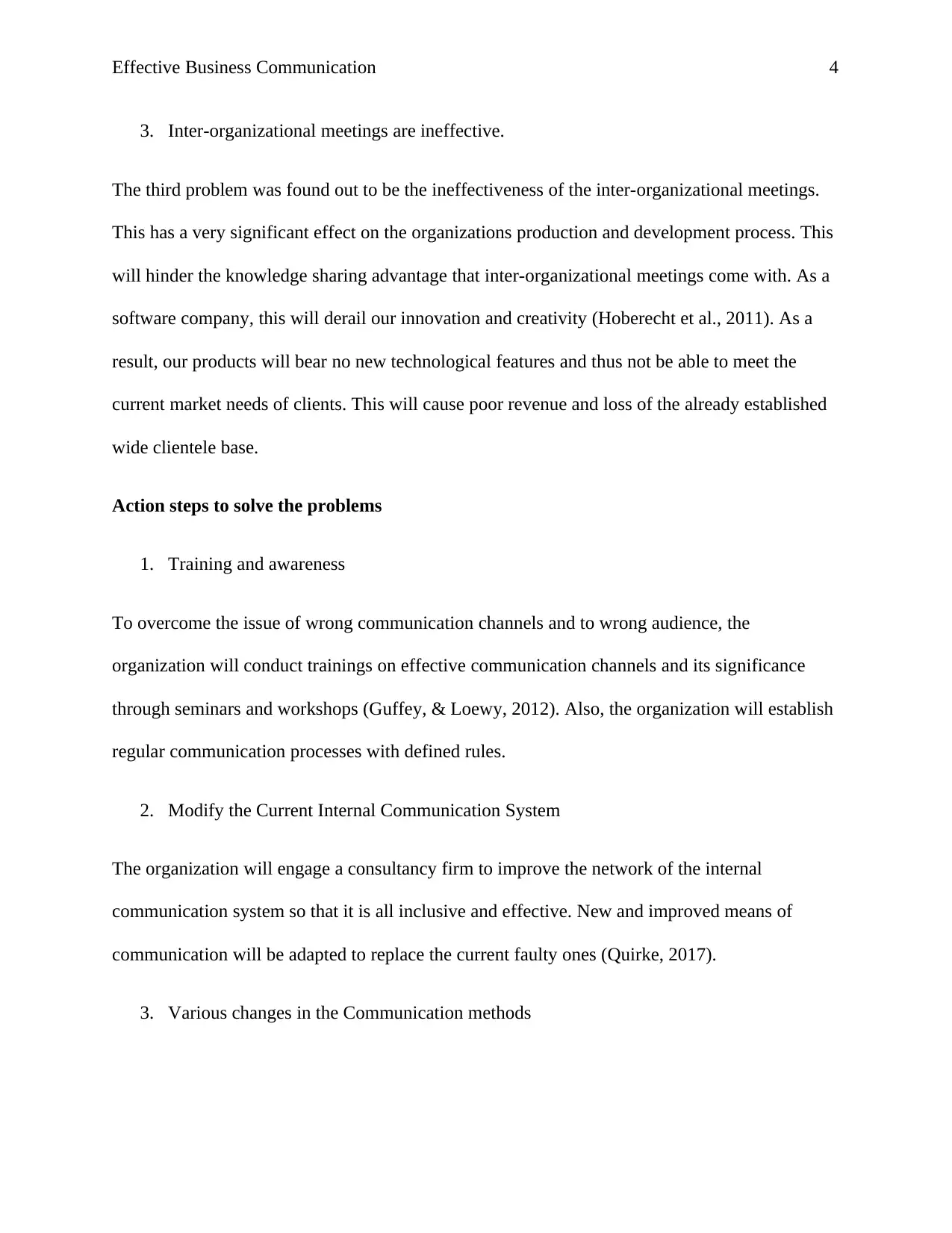
Effective Business Communication 4
3. Inter-organizational meetings are ineffective.
The third problem was found out to be the ineffectiveness of the inter-organizational meetings.
This has a very significant effect on the organizations production and development process. This
will hinder the knowledge sharing advantage that inter-organizational meetings come with. As a
software company, this will derail our innovation and creativity (Hoberecht et al., 2011). As a
result, our products will bear no new technological features and thus not be able to meet the
current market needs of clients. This will cause poor revenue and loss of the already established
wide clientele base.
Action steps to solve the problems
1. Training and awareness
To overcome the issue of wrong communication channels and to wrong audience, the
organization will conduct trainings on effective communication channels and its significance
through seminars and workshops (Guffey, & Loewy, 2012). Also, the organization will establish
regular communication processes with defined rules.
2. Modify the Current Internal Communication System
The organization will engage a consultancy firm to improve the network of the internal
communication system so that it is all inclusive and effective. New and improved means of
communication will be adapted to replace the current faulty ones (Quirke, 2017).
3. Various changes in the Communication methods
3. Inter-organizational meetings are ineffective.
The third problem was found out to be the ineffectiveness of the inter-organizational meetings.
This has a very significant effect on the organizations production and development process. This
will hinder the knowledge sharing advantage that inter-organizational meetings come with. As a
software company, this will derail our innovation and creativity (Hoberecht et al., 2011). As a
result, our products will bear no new technological features and thus not be able to meet the
current market needs of clients. This will cause poor revenue and loss of the already established
wide clientele base.
Action steps to solve the problems
1. Training and awareness
To overcome the issue of wrong communication channels and to wrong audience, the
organization will conduct trainings on effective communication channels and its significance
through seminars and workshops (Guffey, & Loewy, 2012). Also, the organization will establish
regular communication processes with defined rules.
2. Modify the Current Internal Communication System
The organization will engage a consultancy firm to improve the network of the internal
communication system so that it is all inclusive and effective. New and improved means of
communication will be adapted to replace the current faulty ones (Quirke, 2017).
3. Various changes in the Communication methods
Paraphrase This Document
Need a fresh take? Get an instant paraphrase of this document with our AI Paraphraser
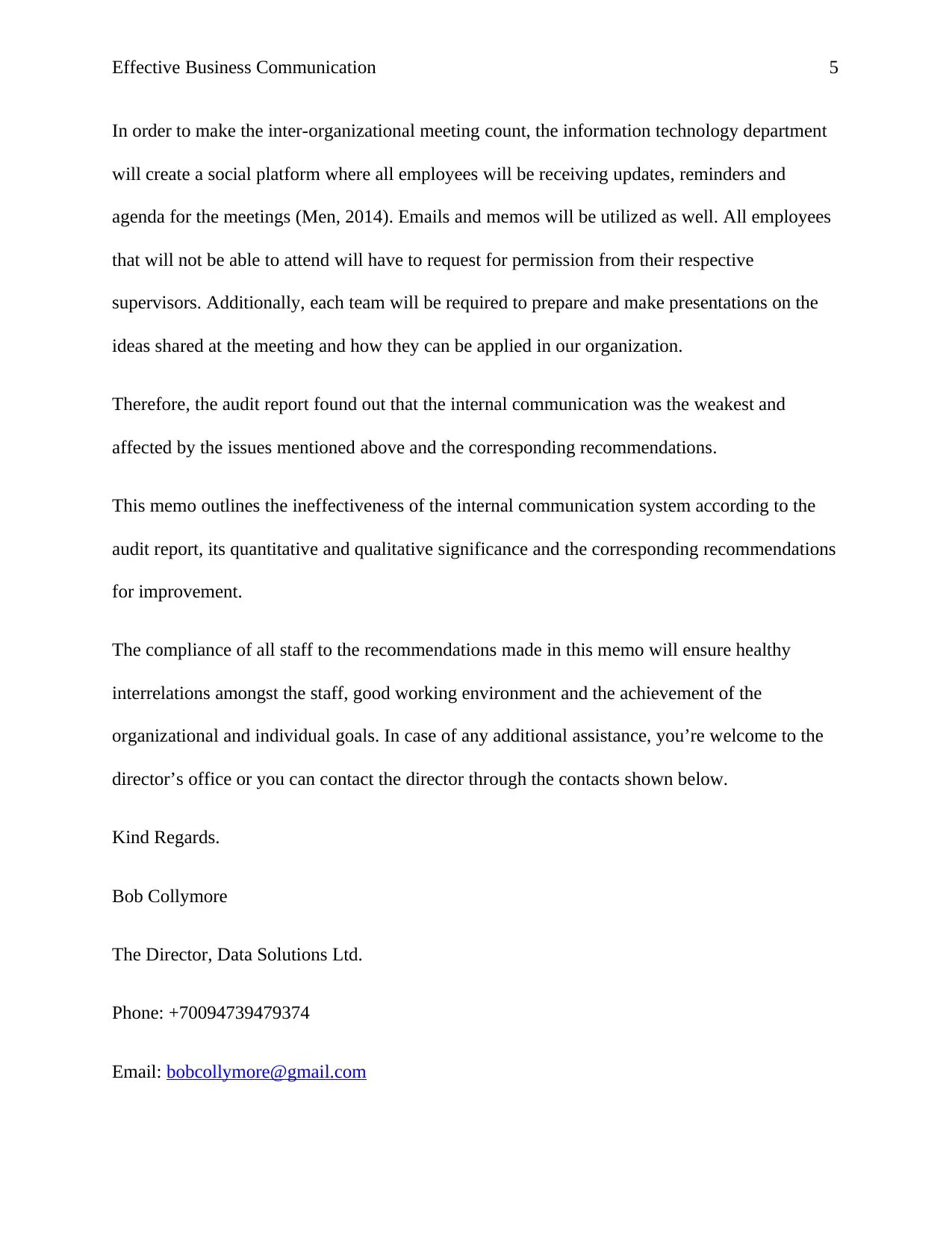
Effective Business Communication 5
In order to make the inter-organizational meeting count, the information technology department
will create a social platform where all employees will be receiving updates, reminders and
agenda for the meetings (Men, 2014). Emails and memos will be utilized as well. All employees
that will not be able to attend will have to request for permission from their respective
supervisors. Additionally, each team will be required to prepare and make presentations on the
ideas shared at the meeting and how they can be applied in our organization.
Therefore, the audit report found out that the internal communication was the weakest and
affected by the issues mentioned above and the corresponding recommendations.
This memo outlines the ineffectiveness of the internal communication system according to the
audit report, its quantitative and qualitative significance and the corresponding recommendations
for improvement.
The compliance of all staff to the recommendations made in this memo will ensure healthy
interrelations amongst the staff, good working environment and the achievement of the
organizational and individual goals. In case of any additional assistance, you’re welcome to the
director’s office or you can contact the director through the contacts shown below.
Kind Regards.
Bob Collymore
The Director, Data Solutions Ltd.
Phone: +70094739479374
Email: bobcollymore@gmail.com
In order to make the inter-organizational meeting count, the information technology department
will create a social platform where all employees will be receiving updates, reminders and
agenda for the meetings (Men, 2014). Emails and memos will be utilized as well. All employees
that will not be able to attend will have to request for permission from their respective
supervisors. Additionally, each team will be required to prepare and make presentations on the
ideas shared at the meeting and how they can be applied in our organization.
Therefore, the audit report found out that the internal communication was the weakest and
affected by the issues mentioned above and the corresponding recommendations.
This memo outlines the ineffectiveness of the internal communication system according to the
audit report, its quantitative and qualitative significance and the corresponding recommendations
for improvement.
The compliance of all staff to the recommendations made in this memo will ensure healthy
interrelations amongst the staff, good working environment and the achievement of the
organizational and individual goals. In case of any additional assistance, you’re welcome to the
director’s office or you can contact the director through the contacts shown below.
Kind Regards.
Bob Collymore
The Director, Data Solutions Ltd.
Phone: +70094739479374
Email: bobcollymore@gmail.com
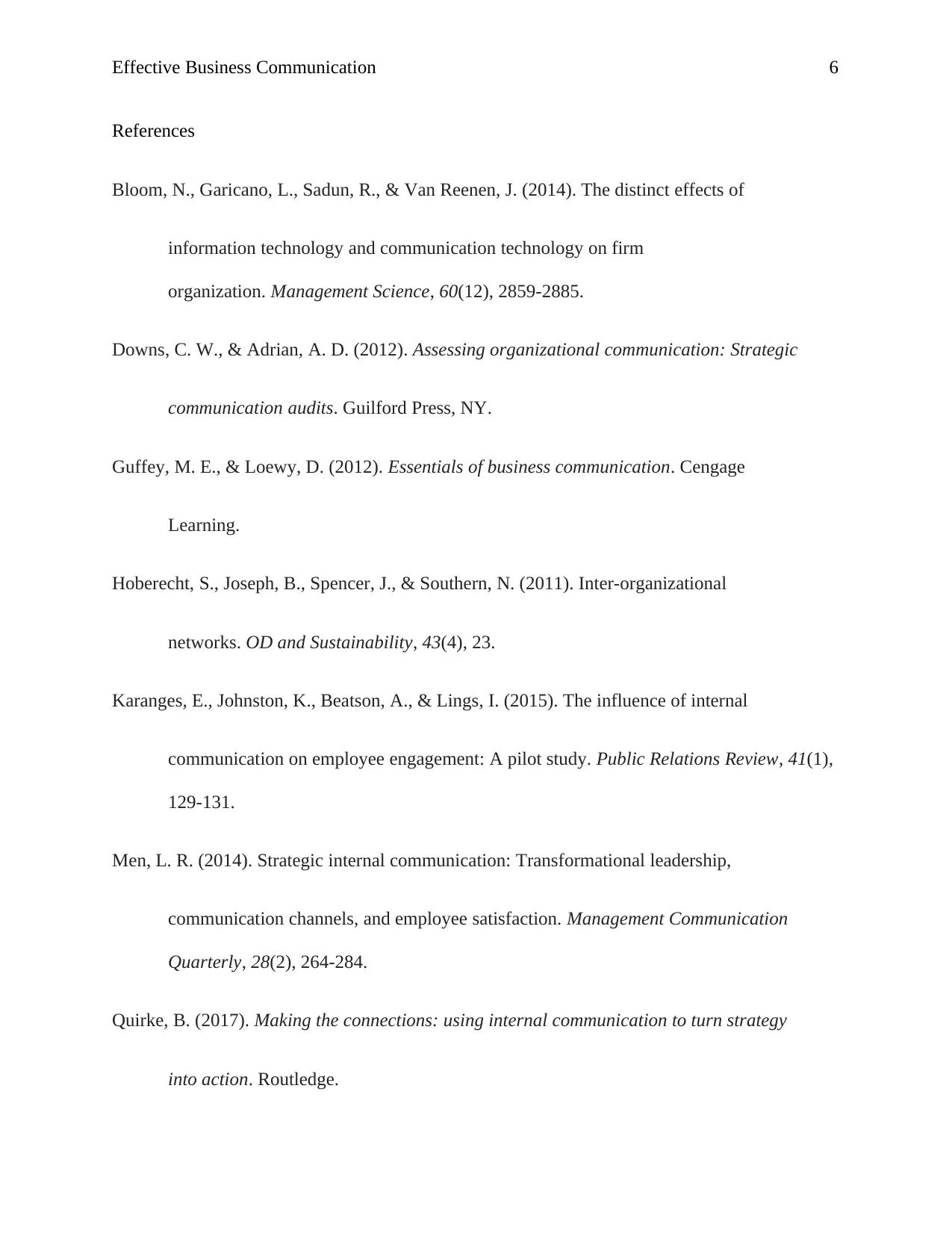
Effective Business Communication 6
References
Bloom, N., Garicano, L., Sadun, R., & Van Reenen, J. (2014). The distinct effects of
information technology and communication technology on firm
organization. Management Science, 60(12), 2859-2885.
Downs, C. W., & Adrian, A. D. (2012). Assessing organizational communication: Strategic
communication audits. Guilford Press, NY.
Guffey, M. E., & Loewy, D. (2012). Essentials of business communication. Cengage
Learning.
Hoberecht, S., Joseph, B., Spencer, J., & Southern, N. (2011). Inter-organizational
networks. OD and Sustainability, 43(4), 23.
Karanges, E., Johnston, K., Beatson, A., & Lings, I. (2015). The influence of internal
communication on employee engagement: A pilot study. Public Relations Review, 41(1),
129-131.
Men, L. R. (2014). Strategic internal communication: Transformational leadership,
communication channels, and employee satisfaction. Management Communication
Quarterly, 28(2), 264-284.
Quirke, B. (2017). Making the connections: using internal communication to turn strategy
into action. Routledge.
References
Bloom, N., Garicano, L., Sadun, R., & Van Reenen, J. (2014). The distinct effects of
information technology and communication technology on firm
organization. Management Science, 60(12), 2859-2885.
Downs, C. W., & Adrian, A. D. (2012). Assessing organizational communication: Strategic
communication audits. Guilford Press, NY.
Guffey, M. E., & Loewy, D. (2012). Essentials of business communication. Cengage
Learning.
Hoberecht, S., Joseph, B., Spencer, J., & Southern, N. (2011). Inter-organizational
networks. OD and Sustainability, 43(4), 23.
Karanges, E., Johnston, K., Beatson, A., & Lings, I. (2015). The influence of internal
communication on employee engagement: A pilot study. Public Relations Review, 41(1),
129-131.
Men, L. R. (2014). Strategic internal communication: Transformational leadership,
communication channels, and employee satisfaction. Management Communication
Quarterly, 28(2), 264-284.
Quirke, B. (2017). Making the connections: using internal communication to turn strategy
into action. Routledge.
⊘ This is a preview!⊘
Do you want full access?
Subscribe today to unlock all pages.

Trusted by 1+ million students worldwide
1 out of 6
Related Documents
Your All-in-One AI-Powered Toolkit for Academic Success.
+13062052269
info@desklib.com
Available 24*7 on WhatsApp / Email
![[object Object]](/_next/static/media/star-bottom.7253800d.svg)
Unlock your academic potential
Copyright © 2020–2025 A2Z Services. All Rights Reserved. Developed and managed by ZUCOL.


